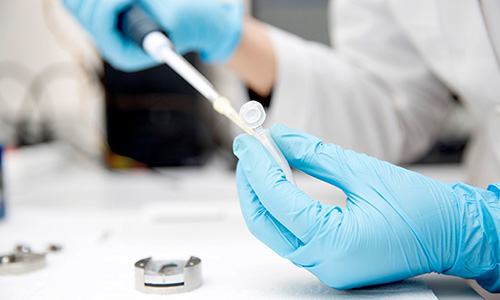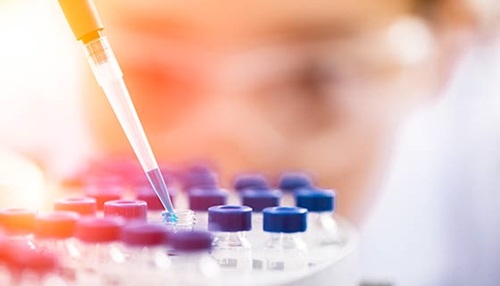Can You Die From Fluid on the Lungs?
COVID-xix Lung Damage
Featured Experts:
Like other respiratory illnesses, COVID-19 tin can cause lasting lung damage. As we go on to acquire well-nigh COVID-19, nosotros're understanding more regarding how information technology affects the lungs during astute affliction and afterwards.
Panagis Galiatsatos, M.D., One thousand.H.S., is an expert on lung disease at Johns Hopkins Bayview Medical Center and sees patients with COVID-19. He explains some of the short- and long-term lung problems brought on past the new coronavirus.
What does COVID do to lungs?
COVID-19 can cause lung complications such as pneumonia and, in the most severe cases, astute respiratory distress syndrome, or ARDS. Sepsis, another possible complexity of COVID-xix, tin also cause lasting harm to the lungs and other organs.
"Equally we accept learned more most SARS-CoV-2 and resulting COVID-nineteen, nosotros have discovered that in severe COVID-19, a pregnant pro-inflammatory condition can result in several critical diseases, complications and syndromes," Galiatsatos says.
COVID-19 Pneumonia
In pneumonia, the lungs go filled with fluid and inflamed, leading to breathing difficulties. For some people, animate problems can get astringent plenty to crave treatment at the hospital with oxygen or fifty-fifty a ventilator.
The pneumonia that COVID-19 causes tends to have hold in both lungs. Air sacs in the lungs fill with fluid, limiting their power to take in oxygen and causing shortness of breath, cough and other symptoms.
While nearly people recover from pneumonia without any lasting lung impairment, the pneumonia associated with COVID-19 can be severe. Even later the disease has passed, lung injury may outcome in breathing difficulties that might accept months to ameliorate.
Acute Respiratory Distress Syndrome (ARDS)
As COVID-19 pneumonia progresses, more of the air sacs become filled with fluid leaking from the tiny blood vessels in the lungs. Somewhen, shortness of breath sets in, and can pb to acute respiratory distress syndrome (ARDS), a form of lung failure. Patients with ARDS are often unable to breath on their own and may require ventilator back up to assistance broadcast oxygen in the body.
Whether information technology occurs at home or at the hospital, ARDS can be fatal. People who survive ARDS and recover from COVID-xix may accept lasting pulmonary scarring.
Sepsis
Another possible complexity of a severe case of COVID-19 is sepsis. Sepsis occurs when an infection reaches, and spreads through, the bloodstream, causing tissue damage everywhere it goes.
"Lungs, centre and other body systems work together similar instruments in an orchestra," Galiatsatos says. "In sepsis, the cooperation betwixt the organs falls apart. Entire organ systems can start to shut down, i after another, including the lungs and center."
Sepsis, even when survived, can exit a patient with lasting harm to the lungs and other organs.
Superinfection
Galiatsatos notes that when a person has COVID-xix, the immune system is working hard to fight the invader. This can go out the body more vulnerable to infection with another bacterium or virus on top of the COVID-19 — a superinfection. More infection can upshot in additional lung damage.

Coronavirus (COVID-19) Email Alerts
Sign up to receive coronavirus (COVID-19) email updates from Johns Hopkins Medicine.
Three Factors in Coronavirus Lung Damage
Galiatsatos notes 3 factors that affect the lung damage adventure in COVID-19 infections and how likely the person is to recover and regain lung function:
Affliction severity. "The showtime is the severity of the coronavirus infection itself — whether the person has a mild case, or a severe one," Galiatsatos says. Milder cases are less likely to crusade lasting scars in the lung tissue.
Health conditions. Galiatsatos says, "The 2d is whether there are existing health problems, such as chronic obstructive pulmonary illness (COPD) or heart illness that can raise the risk for severe disease." Older people are besides more vulnerable for a severe case of COVID-19. Their lung tissues may exist less rubberband, and they may have weakened immunity considering of advanced age.
Treatment. "Treatment is the third factor," he says. "A patient's recovery and long-term lung health is going to depend on what kind of intendance they get, and how quickly." Timely back up in the hospital for severely sick patients can minimize lung damage.
Can coronavirus patients lessen the chance of lung damage?
There are things patients tin practice to increase their chances for less severe lung damage, Galiatsatos says.
"If you accept a health issue that puts yous at higher run a risk, brand certain y'all're doing everything you can to minimize the chance of contracting the virus. Also, make certain that your chronic health atmospheric condition are managed as well as they tin can be. For example, people living with diabetes, COPD or eye disease should be especially conscientious to manage those conditions with monitoring and taking their medications every bit directed."
Galiatsatos adds that proper diet and hydration can too aid patients avoid complications of COVID-19. "Staying well fed is important for overall health. Proper hydration maintains proper blood book and healthy mucous membranes in the respiratory system, which can help them better resist infection and tissue damage."

Coronavirus: Smoking, Vaping, Wildfire Smoke and Air Pollution
Our expert, Panagis Galiatsatos, M.D., M.H.S. discusses how smoking, vaping and air pollution might increase the severity of COVID-xix. Larn about how each of these could affect a COVID-19 diagnosis.
Is COVID-19 lung damage reversible?
After a serious case of COVID-nineteen, a patient's lungs tin can recover, but not overnight. "Recovery from lung damage takes fourth dimension," Galiatsatos says. "In that location's the initial injury to the lungs, followed by scarring. Over time, the tissue heals, merely it can have three months to a twelvemonth or more for a person's lung function to return to pre-COVID-19 levels.
"Lung healing in of itself can produce symptoms," Galiatsatos says. "Information technology is similar to a leg bone breaking, needing a cast for months, and having the cast come off. No one would wait to begin to run right abroad with the newly-healed leg bone. As the leg strengthens and muscle re-grows, patients will experience discomfort from this healing. This is what our lungs go through, too!"
He notes that doctors and patients alike should be prepared for continuing treatment and therapy.
"Once the pandemic is over, there will be a group of patients with new health needs: the survivors. Doctors, respiratory therapists and other health intendance providers will need to help these patients recover their lung function as much as possible."

Coronavirus (COVID-19)
What you need to know from Johns Hopkins Medicine.
Source: https://www.hopkinsmedicine.org/health/conditions-and-diseases/coronavirus/what-coronavirus-does-to-the-lungs
